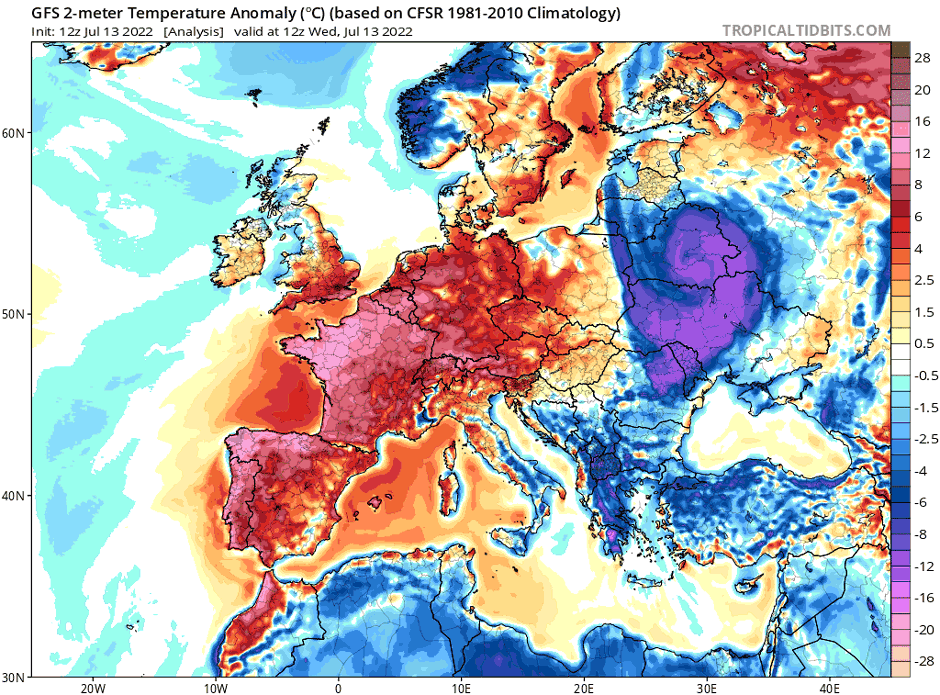Temperatures cooled briefly on Wednesday. But still, many of the United Kingdom’s railway lines—already reeling from buckled tracks, fires, and downed overhead lines—were not running, forcing University of Miami researcher Sharan Majumdar to alter his travel plans during two days in England, where he is visiting the European Centre for Medium-Range Weather Forecasts to conduct hurricane research.
Workers for Network Rail, which manages the railway infrastructure in England, Scotland, and Wales, have painted “hot spot” sections of train tracks white, so they absorb less heat, in hopes of preventing further buckling under the intense heat.
“But other transportation systems have been affected by the hot weather as well—melted roads and airport runways that were not designed for temperatures in the 100s,” Majumdar said, alluding to the fact that in Stockport, England, a busy thoroughfare turned into sticky, black goo.
But the record-breaking heat wave that is scorching Europe is not only impacting the ways in which people get around. It is also affecting other critical infrastructure, leading government and private-sector officials to take unprecedented measures in a bid to prevent catastrophic failures. Power stations, for example, are operating at lower levels, and natural gas pipelines are restricting the flow of gas.
Seeking cooler temperatures inside the confines of buildings, however, has provided little relief.
“Here in the UK, the main priority of building developers is to protect its occupants against the cold weather during the winter. Very little attention is paid to the summer,” explained Majumdar, a professor of atmospheric sciences at the Rosenstiel School of Marine, Atmospheric, and Earth Science, who is also co-director of the new Climate Resilience Academy.
He noted a 2008 report by the London-based market research firm Mintel that found that just 0.5 percent, or 1 in 200, homes in the UK have air-conditioning.
“Most businesses and even hospitals also don’t have air-conditioning,” he pointed out. “It is widely quoted that air-conditioning is not good for the environment and that it will only be needed for a few days each year. To exacerbate the impacts, many residential buildings have large windows and glass doors to allow incoming light,” he added. “During the peak of the heat wave, most people, including my mother and myself, stayed indoors and relied on sitting and sleeping near portable desk fans, staying hydrated, having damp towels nearby, and keeping the windows and curtains closed all day.”
The devastating heat wave, which has spawned ferocious wildfires, seems to be associated with an upper level “cut-off low” that is pumping in heat from North Africa, according to Ben Kirtman, professor of atmospheric sciences at the Rosenstiel School and director of the Cooperative Institute for Marine and Atmospheric Studies.
“The cut-off low, the North Atlantic Subtropical High (NASH), and Saharan air are all working together on this heat wave,” Kirtman said, noting that the NASH, which is also known as the Azores High, and Saharan winds are intimately connected. “Saharan air flow is affected when the NASH intensifies or wobbles,” he explained. “Normally, heat records are broken by a couple of tenths of a degree, but for this heat wave, records are being broken by a couple of degrees. It’s absolutely amazing.”

The Rosenstiel School component of the multi-institutional, long-range forecast project known as the Subseasonal Experiment, or SubX, which Kirtman developed, performed remarkably well in predicting the heat wave weeks in advance, he acknowledged.
Climate change, according to Kirtman, has significantly increased the chances and magnitude of intense heat waves, a sentiment Majumdar echoed.
“The overwhelming consensus in the UK is that climate change is the main driver behind the recent warm and dry summers with record-breaking high temperatures,” he stated. “However, despite the consensus, little has been done in recent years to make the UK’s buildings, transportation infrastructure, economy, and society more resilient to these impacts.”
Whatever the future holds, the blistering heat wave for now is wreaking havoc on Europe’s infrastructure, turning some roads into liquid surfaces and putting railways at risk.
“Some asphalt surfaces can become soft and greasy at elevated temperatures,” said Ali Ghahremaninezhad, an associate professor in the College of Engineering’s Department of Civil and Architectural Engineering. “Modified materials have emerged to improve heat resistance of asphalt surfaces in recently built roadways. But some old asphalt surfaces were built using old materials, and, as such, are susceptible to extreme heat.”
And the UK is a much older region with historic streets that may not be able to withstand intense heat, said Esber Andiroglu, associate professor of practice in the Department of Civil and Architectural Engineering.
“The UK’s infrastructure is designed and built to withstand colder climate conditions,” he explained. “As such, materials and construction standards may not be aligned well with extreme heat events. Moving forward, with more frequent extreme weather events anticipated because of climate change, design and construction guidelines in the UK may need to be reevaluated and re-established.”
Ghahremaninezhad, who is developing self-healing concrete, said such a strategy could be employed to help prevent melting roadways in the UK. “Self-healing methodologies, including self-healing asphalt and concrete, can be used to mitigate cracking in structures and roadways. And the melting issue could be prevented by using modified materials in the construction stage of roadways,” he said.
Meanwhile, the brutal heat wave in Europe has led to a spike in energy demands, according to Nurcin Celik, an associate professor of industrial engineering who is an expert on microgrids and distributed sustainable energy sources.
“This spike in the energy demand may have been forecasted by the European utility companies, and they either have energy reserved for such an event or bring additional generation capacity online to meet the excess demand,” she said. “In the best-case scenario, the heat wave would have minimal effect on consumers, as the additional supply is readily available like having a savings account for energy. Otherwise, this spike may result in scattered brownouts as consumer loads get disconnected to sustain the grid’s stability.”
But if demand persists without energy reserves or additional generation capacity, the utility companies may either disconnect a larger portion of consumers or apply surge charges for the cost of supplying energy beyond the grid’s rated capacity, according to Joshua Darville, a Ph.D. candidate in industrial engineering. “The energy price to consumers is a function of multiple factors, including high demand with low supply and prevention against the long-term damage sustained by overloading the grid,” he said.
The searing conditions may only worsen well into the future, Majumdar warned. He called attention to the fact that Stephen Belcher, chief scientist of the Met Office, the UK’s national weather service, stated that under a very high emissions scenario, the UK could see temperatures exceeding 40 degrees Celsius (about 104 degrees Fahrenheit) as frequently as every three years by the end of the century.
“A lot of work clearly needs to be done,” Majumdar said.

